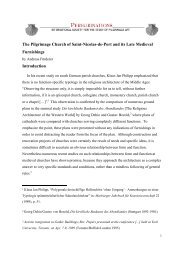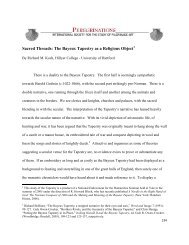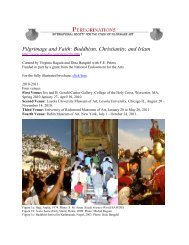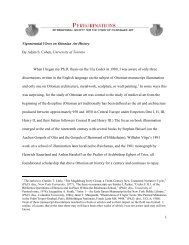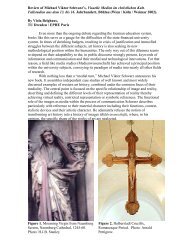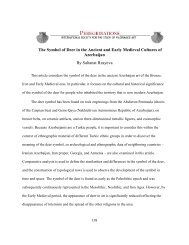The Bayeux Tapestry and the Vikings - Peregrinations
The Bayeux Tapestry and the Vikings - Peregrinations
The Bayeux Tapestry and the Vikings - Peregrinations
You also want an ePaper? Increase the reach of your titles
YUMPU automatically turns print PDFs into web optimized ePapers that Google loves.
<strong>Tapestry</strong>, which had been exhibited in <strong>the</strong> public library in <strong>Bayeux</strong> since 1842, 17 seems to<br />
have played a surprisingly small role. Only <strong>the</strong> publication of Estrup’s journal drew<br />
attention to <strong>the</strong> Sc<strong>and</strong>inavian elements in <strong>the</strong> <strong>Tapestry</strong>’s images. When a piece of<br />
narrative embroidery was found in <strong>the</strong> storage building of <strong>the</strong> church at Ofverhogdals, in<br />
Norway, in 1912, <strong>the</strong>re was only a very summary note establishing a parallel with <strong>the</strong><br />
<strong>Bayeux</strong> <strong>Tapestry</strong>. 18 Le Livre du Millénaire de la Norm<strong>and</strong>ie included <strong>the</strong> paper read by<br />
Emile Travers at <strong>Bayeux</strong> in 1906, in which he suggested that <strong>the</strong> <strong>Bayeux</strong> <strong>Tapestry</strong> had<br />
been created in Engl<strong>and</strong>, for Odo of <strong>Bayeux</strong>, between 1088 <strong>and</strong> 1092. 19 <strong>The</strong> city of<br />
Rouen published <strong>the</strong> proceedings of a learned conference associated with <strong>the</strong> anniversary<br />
<strong>and</strong> included <strong>the</strong> opposing opinion that Eugene Anquetil had published in 1907 whereby<br />
he argued that <strong>the</strong> <strong>Tapestry</strong> had been created in <strong>Bayeux</strong>, for Bishop Odo, for exhibition at<br />
<strong>the</strong> dedication of his ca<strong>the</strong>dral in 1077. 20 <strong>The</strong> Norman scholars failed to see <strong>the</strong><br />
Embroidery as a visual affirmation of <strong>the</strong>ir Sc<strong>and</strong>inavian roots.<br />
In nineteenth-century literature, <strong>Vikings</strong> were often associated with ships. But<br />
nothing was known about <strong>the</strong> actual appearance of early Nordic vessels, <strong>and</strong> some of <strong>the</strong><br />
illustrations were extremely fanciful. One good example is <strong>the</strong> engraving for <strong>the</strong> 1825<br />
edition of Frithiof’s Saga, a heroic poem composed by <strong>the</strong> Swedish author Esaias Tegnér,<br />
in which <strong>the</strong> Viking’s boat was transformed into a fabulous dragon, probably following<br />
<strong>the</strong> description in <strong>the</strong> sagas.<br />
17 Shirley Ann Brown, <strong>The</strong> <strong>Bayeux</strong> <strong>Tapestry</strong>. History <strong>and</strong> Bibliography (Woodbridge: Boydell, 1988), 15.<br />
18 Thn E., “Ofverhogdals-Tapeten,” Konst (1 March 1912): 74-75.<br />
19 Travers Emile, “La tapisserie de <strong>Bayeux</strong>,” Livre du Millénaire de la Norm<strong>and</strong>ie, (Rouen <strong>and</strong> Paris: G.<br />
Ficker, 1911), 1:153-156.<br />
20 Eugène Anquetil, “Antiquité de la Tapisserie de <strong>Bayeux</strong>,” Congrès du Millénaire de la Norm<strong>and</strong>ie tenu à<br />
Rouen (Rouen, 1912), 405-409.<br />
32



